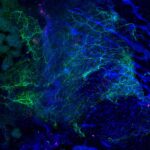Link to Pubmed [PMID] – 26877243
Link to DOI – 10.1016/j.it.2016.01.006S1471-4906(16)00007-7
Trends Immunol 2016 Mar; 37(3): 181-192
Recent findings have revealed distinct roles for type I and II interferons (IFN-I and IFN-γ) in the recruitment of immune cells to the central nervous system (CNS) and highlighted the importance of this process for brain maintenance and protection/repair. Furthermore, manipulation of IFN-I and IFN-γ pathways in pathological contexts has yielded conflicting results. We discuss these findings, focusing on two distinct conditions; relapsing remitting multiple sclerosis (RRMS) and brain aging. Using these examples, we propose that regulation of immune cell entry to the CNS is a mechanism through which interaction between IFN-I and -II can affect brain function from its anatomical borders. Deviation from homeostatic IFN-I/-II balance may contribute to distinct brain pathologies, resulting from either insufficient immune surveillance of the CNS and loss of immune-dependent protection, or overwhelming leukocyte entry and immune-mediated destruction.

